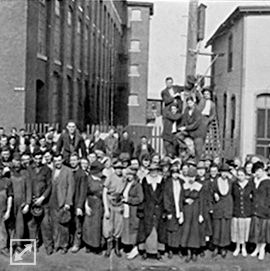Focal Places in Burlington
The South End: Cultural History
Burlington is a city on a hill and according to Ellin Anderson’s book, “We Americans: A Study of Cleavage in an American City,” in the early industrial era of Burlington’s history, the socioeconomic tiers correlated with the city’s topography of vertical terraces. With the University at the top, so were the homes of the affluent academics. With the shops and businesses on Church Street, so were the mid-range merchants. 
Aerial View of Burlington looking north, 1939And on the lowest terrace, the manufacturing and industrial hub also housed the lowest paid, blue-collar workers (1937). This lowest terrace encompasses the entire south end.
Anderson also described various neighborhoods delineated by economic status, and, subsequently, culture and ethnicity. The ward which included the industrial tier encompassing the south end was “looked upon as ‘foreign.’” In the 1930’s when her book was published, the workers who lived in these neighborhoods of factory housing were predominantly French Canadian, German, and Irish (1937). These immigrant groups worked in the lumberyards, stone yards, coal storage facilities, factories, and mills.
Despite low wages, the mills and industries provided work opportunities that drew many families from Canada. Over time, the French-speaking residents of Burlington clustered in specific regions 
Lakeside neighborhood workers
for the Queen City Cotton
Mill, circa 1900. UVM Special Collectionsof the city—one of those being the south end Lakeside neighborhood which became known as “Petit Canada.” Local historians, Judy Dow and Kim Chase, have shared accounts of this neighborhood which was also the location of the Queen City Cotton Company (from 1890-1938) and the Blodgett Oven factory.
Residents of “Petit Canada” were a mix of both ethnically French Canadian and people who were known as “French Indians.” However, because of the notorious activities of the eugenics program in Vermont, many of these French Indians disguised and denied their native ancestry. This has made it difficult to find records of the many native people who comprised the south end industrial work force. Historic accounts by Dow and Chase, have helped to reveal this discrepancy in Burlington’s historic literature.
Sources:
Special thanks to local contributor, Judy Dow, for her expertise and support.
Andersen, E.L. (1937) We Americans: A Study of Cleavage in an American City. New York, NY: Russell & Russell.
Guyette, E. (2013) The French Settlement of Vermont: 1609-1929. The Flow of History: Gathering and Interactions of Peoples, Cultures, and Ideas. Retrieved from: http://www.flowofhistory.org/themes/movement_settlement/french.php
Obenaur, K. (2014) Lakeside Avenue Manufacturing. Mills and Factories: Manufacturing heritage sites in Burlington and Winooski, Vermont. Retrieved from: http://www.uvm.edu/~hp206/2013/pages/obenauer/index.html